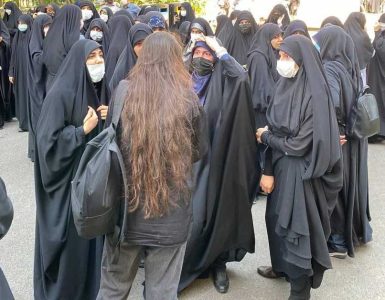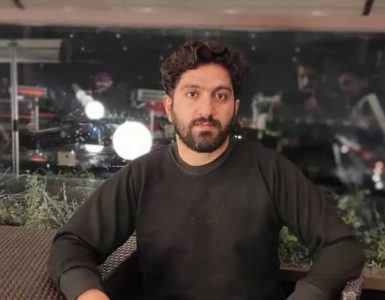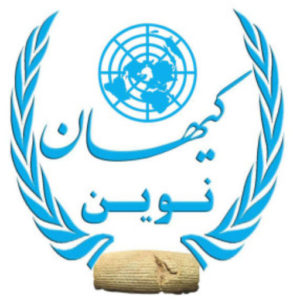نتیجه تحقیقات مشترک شبکه خبرنگاران سه رسانه سراسری آلمان درباره شکنجه در زندانهای جمهوری اسلامی پرده از خشونتی هولناک علیه بازداشت شدگان اعتراضات اخیر ایران برمیدارد. شبکهای از خبرنگاران کانالهای تلویزیونی NDR, WDR و روزنامه زود دویچه (SZ) پس از گفتوگو با افرادی که در جریان اعتراضات اخیر بازداشت شدند و یک زندانبان که موفق به خروج از ایران شده، روز چهارشنبه اول فوریه (۱۲ بهمن) گزارشی را در اینباره منتشر کردهاند.
این گزارش که توسط بامداد اسماعیلی، فرانک رفیعی، رایکو پینکرت و دانیل درپر تهیه شده، با روایت دختری با نام مستعار لاله، آغاز میشود. لاله و دوستش در حال بازگشت از کلاس گیتار به خانه بودند که با جمعی از زنانی که مشغول تظاهرات علیه حکومت هستند، روبرو میشوند. آنها به این زنان میپیوندند. ناگهان نیروهای امنیتی از راه میرسند و آنها را محاصره کرده و با خود می برند. لاله مجبور میشود تلفن همراهش را تحویل بدهد. مأموران چشمان لاله را بسته و او را با خود میبرند. چهار ساعت بعد لاله به شدت آسیبدیده است.
بنا بر این گزارش، او در بازداشتگاه شاهد آن بوده که چگونه ابتدا پسرهایی را که بازداشت شده بودند روی زمین انداخته و کتک میزنند. بعد نوبت لاله و دوستش میرسد. به گفته لاله چند مأمور که احتمالا مرد بودهاند او را با لگد و شوکر برقی طوری میزنند که کمی بعد تمام پای راستش کبود میشود.
استفاده از شوک الکتریکی برای شکنجه بازداشتشدگان در زندانهای جمهوری اسلامی سابقه طولانی دارد و از این روش برای تخریب روحیه بازداشتیهای اعتراضات اخیر نیز به کرات استفاده شده است. در این گزارش آمده است که بازجوها لاله را تهدید میکنند که اگر دروغ بگوید او را به دست رئیس میسپرند تا کتکاش بزند.
لاله شب قبل از دستگیری چند اعلامیه تهیه کرده بود که در آنها مردم تشویق به شرکت در اعتراضات شده بودند. تعدادی از این اعلامیهها موقع دستگیری هنوز در کیفش بودند. لاله برای این خبرنگاران تعریف کرده که در بازداشتگاه، در یک لحظه مناسب از فرصت استفاده کرده و این اعلامیهها را قورت داده است. لاله به خبرنگاران میگوید: «پس از بازجویی همان جا نشستیم و آنها پشت سر ما شوکرهای برقی را تکان میدادند تا ما را بترسانند.» به گفته لاله “آنها موقع این کار میخندیدند.”
لاله و دوستش نیمههای شب از بازداشتگاه آزاد میشوند. او میگوید از آن زمان دست به گیتارش نزده و وضعیت درسیاش در مدرسه بدتر شده است. پدرش تعریف میکند: «در هفته اول او هر روز گریه میکرد، همیشه درست در همان ساعتی که بازداشتش کرده بودند.»
با وجود این، لاله میگوید اگر دوباره خیابانها شلوغ شود، در تظاهرات شرکت میکند. او میگوید: «چون ما نسلی هستیم که آزادی میخواهیم. هیچ نسلی قبل از ما به اندازه ما شجاع نبوده است.»
خبرنگاران سه رسانه یاد شده در هفتههای گذشته علاوه بر لاله با دهها ایرانی که از زمان شروع اعتراضات بازداشت شدهاند، گفتوگو کردهاند. بسیاری از آنها از رفتارهای بسیار خشنتری گزارش دادهاند. همه آنها گفتهاند که با قرار وثیقه هنگفت یا به شکل مشروط آزاد شدهاند. تقریبا همه این افراد هنوز در ایران هستند.
بیشتر آنها گفتهاند که در حین دستگیری یا بازجویی با باتوم یا مشت مورد ضرب و شتم قرار گرفتهاند و تعدادی نیز از شکستگی استخوان گزارش دادهاند. اکثر معترضانی که خبرنگاران با آنها صحبت کردند گفتهاند که موقع بازجویی چشمان آنها را بسته بودند. یکی از آنها تعریف کرده که چگونه او و همراهانش را وادار کردند تا ۲۴ ساعت تمام چشم بسته زانو بزنند و هرکس حرکتی میکرد کتک میخورد.
علاوه بر شکنجه بدنی، این معترضین گفتهاند که از نظر روانی نیز مرعوب شدهاند. مأموران امنیتی و بازجویان آنها را به اعدام، تجاوز جنسی، شکنجه با شوکر برقی یا ضرب و شتم تهدید کردهاند. برخی از این افراد تعریف کردهاند که برخلاف میلشان به آنها دارو خورانده شده است.
بازداشت شدگان همچنین میگویند که شاهد شلاق زدن به کف پای برهنه، شلاق زدن با شلنگ آب و شکنجه با شوکر برقی دیگر زندانیان بودهاند. مرد جوانی میگوید: «شما صدای فریادها را میشنیدید برای اینکه بترسید و به همه چیز اعتراف کنید.»
در سه مورد از تجاوز و خشونت جنسی گزارش شده است. گفته شده این افراد به وسایل اتاق بسته شده و با باتوم لاستیکی یا برقی مورد تجاوز قرار گرفتهاند. معترضین بازداشت شده به اتفاق آرا گفتهاند که تلفنهای همراه و لپ تاپ آنها هنگام دستگیری گرفته شده و آنها را با تهدید یا شکنجه، وادار به دادن رمز عبور کردهاند.
بازجوها سپس همه آنچه را که آنها در شبکههای اجتماعی، در واتساپ یا اینستاگرام پست کردهاند، چاپ کرده و در مقابلشان قرار دادهاند. به یکی از بازداشتیها عکس بستگانش را که در تظاهرات بزرگ برلین ( ۳۰ مهر/ ۲۲ اکتبر سال گذشته میلادی) علیه جمهوری اسلامی شرکت کرده بودند، نشان دادهاند.
هیچکدام از بازداشتشدگان از حق داشتن وکیل برخوردار نبودهاند. خانوادههای آنها روزها از وضعشان اطلاعی نداشتهاند. یکی از بازداشتشدگان اهل تهران گفته است که حکم بازداشتاش عمومی و بدون نام بوده و هنگامی که پرسیده چرا نامش روی آن نیست، پاسخ شنیده: «این برگه برای بازداشت ۸۰ میلیون ایرانی کفایت میکند.»
خبرنگاران سه رسانه یاد شده یک زندانبان سابق را در آلمان ملاقات کردهاند که موارد شکنجه و آزار زندانیان را تایید میکند. او ۱۰ سال در زندانهای مختلف ایران، حتی تا بعد از شروع اعتراضات کار کرده است. کارت خدمت و فیشهای حقوقی او این موضوع را تایید میکنند.
این زندانبان سابق میگوید که بازداشتشدگان روزی چند بار در زندانها شلاق میخوردند. همکارانش همچنین برای شکنجه از اسپری فلفل، باتوم یا شوکر استفاده میکردند. او در تلفن همراهش فرمی را نشان میدهد که نگهبانان موظف به پر کردن آن بودند. در این فرمها اسامی بازداشتشدگان، تعداد ضربههای شلاقی که خوردهاند و اثر انگشت بازداشتشدگان ثبت میشده است.
او میگوید: «هدف این بود که به معترضان سخت بگذرد، به همین خاطر شکنجه میشدند.» به گفته او رئیس زندان دستور داده بود که “هیچ رحمی” به زندانیان نشود. به خانوادهها اطلاع داده نمیشد. زندانیها را وادار میکردند در اتاقهای سرد با لباسهای نازک زندان، روی زمین سیمانی کنار مدفوع خود بخوابند. او می گوید زمانی دیگر نتوانسته این همه را تحمل کند و فرار کرده است.
سه رسانه آلمانی در گزارش خود یادآور شدهاند که از زمان آغاز اعتراضات به مرگ مهسا امینی در سپتامبر ۲۰۲۲ (شهریور ماه)، راستی آزمایی خبرها و روایتها از ایران برای خبرنگاران دشوار بوده است. با این حال این خبرنگاران به طور سیستماتیک گزارشها را بررسی کرده و توانستند بسیاری از اظهارات معترضین را با اطلاعاتی که به شکل عمومی در دسترس هستند و با جزئیات جغرافیایی مقایسه و بررسی کنند.
بنا بر این گزارش، این اطلاعات همچنین با شرایط زندانها که پیشتر توسط زندانیان در سالهای گذشته توصیف شده بودند، مطابقت داشتهاند. علاوه بر این، خبرنگاران توانستهاند اسناد دادگاهها و زندانها و همچنین عکسها، فیلمها و مدارک پزشکی اکثر موارد توصیفشده را مشاهده کنند. این رسانههای آلمانی نوشتهاند این موارد و همچنین گزارشهای بستگان، دوستان یا پزشکان معالج، اظهارات این افراد را تایید میکند.
افزون بر آن یک گزارش محرمانه وزارت خارجه آلمان نیز که اواخر نوامبر ۲۰۲۲ تهیه شده، یافتههای خبرنگاران آلمانی را تأیید میکند. آنها نوشتهاند در سند وزارت خارجه آلمان از “گزارشهای متعددی از اعترافات اجباری از طریق شکنجه و فشار روانی” در ایران سخن رفته است.
علاوه بر این، “شکنجه روحی و جسمی و رفتارهای غیرانسانی در بازجویی و بازداشت” در میان زندانیان سیاسی در ایران امری رایج است. یک سخنگوی این وزارتخانه در پاسخ به این خبرنگاران گفت: «تجارب وحشتناکی که افراد آسیب دیده بیان کردهاند مطابق گزارشهایی است که برای این وزارتخانه شناخته شده است.»
این مقام وزارت خارجه آلمان گفته است که “علاوه بر تحریمهای موجود، اقدامات بعدی نیز در حال بررسی است.” سفارت ایران در آلمان و وزارت امور خارجه ایران سوالات خبرنگاران شبکههای یاد شده را بی پاسخ گذاشتند.
The result of the joint investigation of the journalists’ network of three national German media about torture in the prisons of the Islamic Republic reveals the horrific violence against the detainees of the recent protests in Iran. A network of reporters from NDR, WDR and Zod Deutsche newspaper (SZ) after talking to people who were arrested during the recent protests and a prison guard who managed to leave Iran, made a report about this on Wednesday, February 1 (Bahman 12). have published
The report, prepared by Bammad Esmaili, Frank Rafiei, Raiko Pinkert and Daniel Draper, begins with the narration of a girl nicknamed Laleh. Laleh and her friend were returning home from guitar class when they encountered a group of women protesting against the government. They join these women. Suddenly, the security forces arrive and surround them and take them away. Laleh is forced to hand over her mobile phone. Officers blindfold Lala and take her away. Four hours later, the tulip is severely damaged.
According to this report, he witnessed in the detention center how the boys who were detained were first thrown on the ground and beaten. Then it’s Laleh and her friend’s turn. According to Laleh, several officers, who were probably men, kicked him with electric shocks so that his right leg was bruised.
The use of electric shocks to torture detainees in the prisons of the Islamic Republic has a long history, and this method has been used many times to destroy the morale of detainees in recent protests. It is stated in this report that the interrogators threaten Laleh that if he lies, they will hand him over to the boss to beat him.
The night before his arrest, Laleh had prepared some leaflets in which people were encouraged to participate in the protests. Some of these leaflets were still in his bag when he was arrested. Laleh explained to these reporters that in the detention center, he used the opportunity at an opportune moment and swallowed these leaflets. “After the interrogation, we sat there and they were waving electric shockers behind us to scare us,” Laleh told reporters. According to Laleh, “They were laughing while doing it.”
Laleh and his friend are released from the detention center in the middle of the night. He says he hasn’t touched his guitar since then and his academic performance at school has worsened. “For the first week, he cried every day, always at the same time he was arrested,” his father recounts.
Despite this, Laleh says he will participate in demonstrations if the streets become crowded again. “Because we are a generation that wants freedom,” he says. “No generation before us has been braver than us.”
In the past weeks, the reporters of the three mentioned media, in addition to Laleh, have talked with dozens of Iranians who have been arrested since the beginning of the protests. Many of them reported much more violent behavior. All are said to have been released on high bail or parole. Almost all of these people are still in Iran.
Most said they were beaten with batons or punches during arrest or interrogation, and a few reported broken bones. Most of the protesters that the reporters talked to said that they were blindfolded during the interrogation. One of them described how he and his companions were forced to kneel for 24 hours with their eyes closed and anyone who made a move was beaten.
Threat of execution
In addition to physical torture, these protesters said that they were also psychologically intimidated. Security officers and interrogators have threatened them with execution, rape, torture with electric shocks or beatings. Some of these people have described that they were given medicine against their will.
Detainees also say that they witnessed whipping on the soles of their bare feet, whipping with a water hose, and torture with electric shocks of other prisoners. “You heard screams to scare you into confessing everything,” says a young man.
Rape and sexual violence were reported in three cases. It is said that these people were tied to the furniture of the room and raped with rubber or electric batons. Arrested protesters have unanimously said that their mobile phones and laptops were taken during their arrest and they were forced to give their passwords by threats or torture.
The interrogators then printed out and placed in front of them everything they had posted on social media, on WhatsApp or Instagram. One of the detainees was shown the photo of his relatives who participated in the big demonstration in Berlin (October 30/October 22 of last year) against the Islamic Republic.
None of the detainees had the right to have a lawyer. Their families did not know about their situation for days. One of the detainees from Tehran said that his arrest warrant was public and anonymous, and when he asked why his name was not on it, he heard the answer: “This document is enough to arrest 80 million Iranians.”
The former prison guard confirms all the cases
Reporters of the three mentioned media have met a former prison guard in Germany, who confirms the cases of torture and abuse of prisoners. He has worked in different prisons in Iran for 10 years, even after the protests started. His service card and salary slips confirm this.
This former prison guard says that detainees were whipped several times a day in prisons. His colleagues also used pepper spray, batons or stun guns for torture. On his cell phone, he shows a form that the guards were required to fill out. In these forms, the names of the detainees, the number of lashes they received, and the fingerprints of the detainees are recorded.
“The goal was to make it difficult for the protesters, so they were tortured,” he says. According to him, the head of the prison ordered that “no mercy” be given to the prisoners. Families were not informed. Prisoners were forced to sleep in cold rooms in thin prison clothes on the cement floor next to their stools. He says that he could not bear all this anymore and ran away.
The German Foreign Ministry has evidence of torture
Three German media have mentioned in their report that since the beginning of the protests against the death of Mahsa Amini in September 2022, it has been difficult for journalists to verify news and narratives from Iran. However, these reporters systematically reviewed the reports and were able to compare and check many of the protestors’ statements with publicly available information and geographic details.
According to the report, the information also matched prison conditions previously described by inmates in previous years. In addition, reporters have been able to view court and prison documents, as well as photos, videos and medical records of most of the described cases. These German media wrote that these cases, as well as the reports of relatives, friends or treating doctors, confirm the statements of these people.
In addition, a confidential report of the German Foreign Ministry prepared at the end of November 2022 confirms the findings of German journalists. They wrote that the German Foreign Ministry document mentions “numerous reports of forced confessions through torture and psychological pressure” in Iran.
In addition, “mental and physical torture and inhumane behaviors during interrogation and detention” are common among political prisoners in Iran. A spokesman for this ministry said in response to these reporters: “The horrific experiences that the affected people have expressed are in accordance with the reports that are known to this ministry.”
The official of the German Foreign Ministry said that “in addition to the existing sanctions, further measures are also being considered.” The Iranian Embassy in Germany and the Ministry of Foreign Affairs of Iran left the questions of the journalists of the mentioned networks unanswered.













